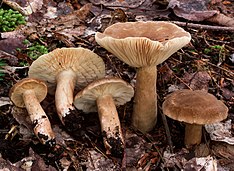Lactarius fumosus
Lactarius fumosus, commonly known as the smoky milkcap, is a species of fungus in the family Russulaceae.
| Lactarius fumosus | |
|---|---|
 | |
| Lactarius fumosus | |
| Scientific classification | |
| Kingdom: | |
| Division: | |
| Class: | |
| Order: | |
| Family: | |
| Genus: | |
| Species: | L. fumosus |
| Binomial name | |
| Lactarius fumosus Peck (1872) | |
| Synonyms[1] | |
|
L. fuliginosus var. fumosus (Peck) Sacc. (1887) | |
| Lactarius fumosus | |
|---|---|
float | |
| gills on hymenium | |
| cap is depressed | |
| hymenium is decurrent | |
| stipe is bare | |
| ecology is mycorrhizal | |
| edibility: unknown | |
Taxonomy
The species was first described by American mycologist Charles Horton Peck in 1872.[2] "Lactarius fumosus" var. fumosus is considered a synonym.[1]
Lactarius fumosus is the type species of the section Fumosi of the subgenus Plinthogalus of the genus Lactarius.[3]
Description
The cap is 3–10 cm (1.2–3.9 in) wide, broadly convex to nearly plane, sometimes shallowly depressed. The margin (cap edge) is irregular, often wavy, and lobed or ribbed. The cap surface is dry, unpolished, azonate, usually becoming somewhat wrinkled with age, pale dingy yellow-brown to whitish overall, with a smoky tinge, sometimes with tawny olive, pinkish buff, or dull brown areas. The gills are attached to subdecurrent (running slightly down the length of the stem), narrow, crowded together, whitish, becoming dingy yellow-buff, staining reddish when bruised. The stem is 4–11 cm (1.6–4.3 in) long, 6–15 mm (0.24–0.59 in) thick, nearly equal, dry, dull, stuffed, colored like the cap, whitish towards the base, staining reddish, but more slowly than the gills. The flesh is pale white, staining reddish-salmon when cut. Its odor is not distinctive, but the taste is variable: quickly acrid then mild then slowly staining acrid, or very slowly faintly acrid. The latex is white on exposure, unchanging, staining tissues reddish. The spore print is pinkish-buff. The edibility is unknown.[4]
Microscopic characters
The spores are 6–8 by 6–8 µm, spherical or nearly so, ornamented with ridges that form a partial reticulum, prominences up to 1.5 µm high, hyaline (translucent), amyloid. The cap cuticle is a palisade of cylindrical to club-shaped cells.[4]
Similar species
Lactarius musciola has darker colors, and its gills do not stain reddish where bruised.[4] Lactarius fuliginosus differs in having broad subdistant gills.[5]
Habitat and distribution
The fruit bodies of L. fumosus grow solitary, scattered, or in groups on the ground in woods from July–October. The fungus is widely distributed in eastern North America, and has also been reported from western Canada. Its frequency of occurrence is described as occasional.[4] Its range extends south to northwestern Mexico, where it is found associated with Liquidambar, Magnolia, Acer, and Quercus species.[5]
Bioactive compounds
Extracts of the fruit bodies are toxic to the corn earworm, Heliothis zea and the large milkweed bug, Oncopeltus fasciatus. The insecticidal activity is thought to be caused by compounds called chromenes.[6]
See also
References
- "Lactarius fumosus Peck 1872". MycoBank. International Mycological Association. Retrieved 2010-07-10.
- Peck CH. (1872). "Report of the Botanist (1870)". Annual Report on the New York State Museum of Natural History. 24: 74.
- Hesler and Smith, 1979, p. 103.
- Bessette AR, Bessette A, Harris DM (2009). Milk Mushrooms of North America: A Field Guide to the Genus Lactarius. Syracuse: Syracuse University Press. pp. 177–78. ISBN 0-8156-3229-0.
- Guevara G, Garcia J, Castillo J, Miller OK (1987). "New records of Lactarius in Mexico". Mycotaxon. 30: 157–76. Retrieved 2010-05-01.
- Dowd PF, Miller OK (1990). "Insecticidal properties of Lactarius fuliginosus and Lactarius fumosus". Entomologia experimentalis et applicata. 57 (1): 23–28. doi:10.1007/BF00349592.
Cited text
- Hesler LR, Smith AH (1979). North American Species of Lactarius. Michigan: The University of Michigan Press. ISBN 0-472-08440-2.